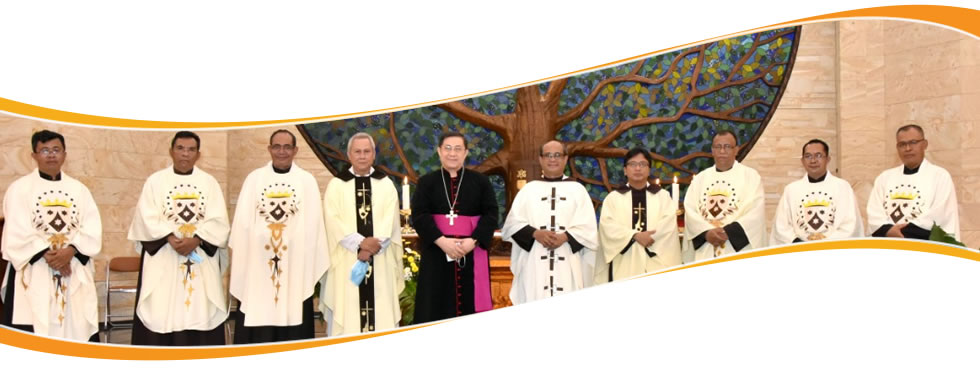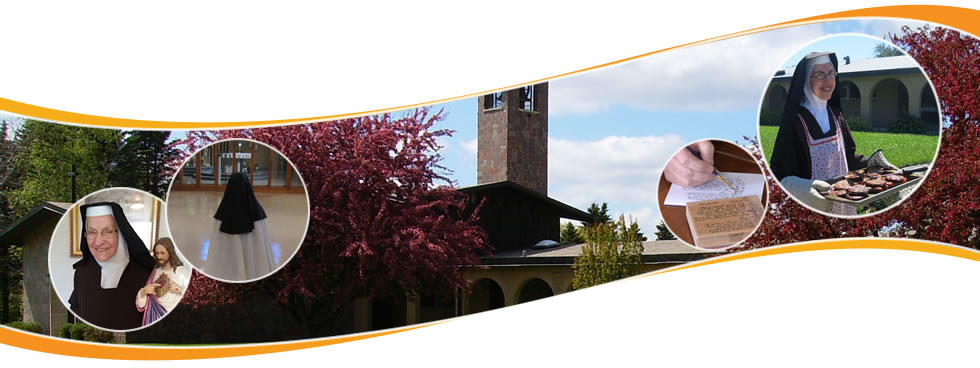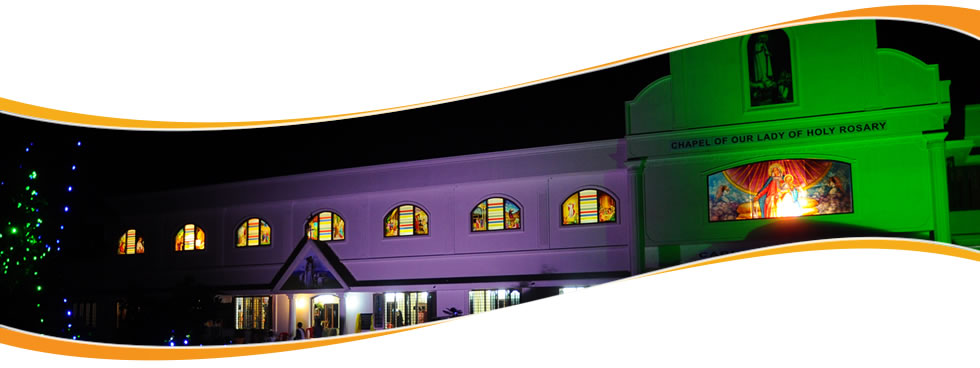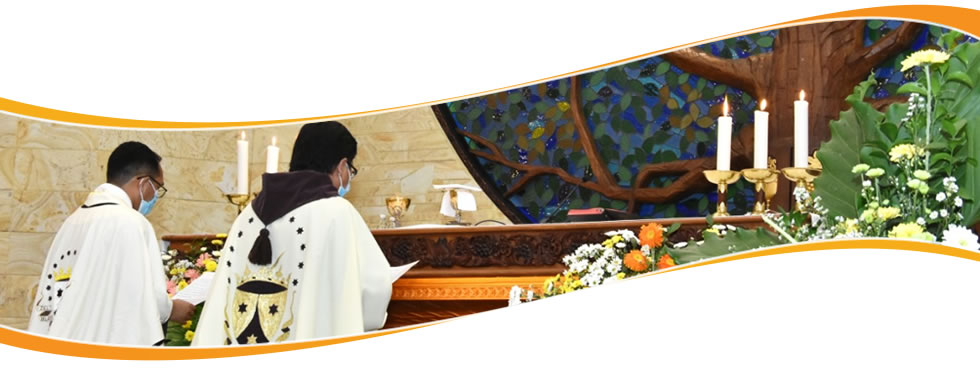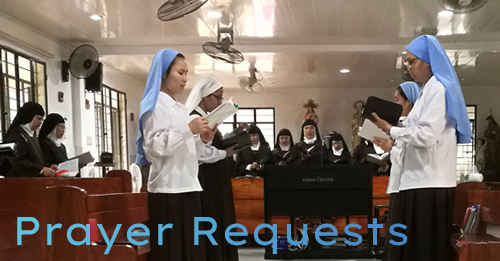Interview With Its Writer
Story Behind the Icon for the 100th Anniversary of the Indonesian Province
An icon written for the 100th anniversary of the Indonesian Province which concluded a short time ago has an interesting history and an interesting writer. The Icon will find a permanent home in the provincial house of the Indonesian Province. It is hoped that it becomes both a tool of prayer and a sign of courage to be the true light of God to others and the good follower of Jesus Christ.” according to its creator.
She was born into a Christian family although her mother, born in Bali, was Buddhist. Her parents enrolled her into a Catholic secondary school under the care of the Sisters of Perpetual Help. One of the nuns, Sr. Flora took care of her when she was sick and became her private teacher after school in the area of math, religion and catechism. Two years later, Sr. Flora invited her to become a Catholic and gave her the baptismal name of Cecilia. “However, as she was filling out the form for the baptism, Sr. Flora received a message in prayer that her name should be Marina Carmel. So Our Lady of Mount Carmel became my patron saint. This was my first contact with the Carmelites.”
Following an accident involving her hands, Marina Carmel had the opportunity to learn from Orthodox nuns and priests how to write icons. “They encouraged me, improving my ability to use my injured hands. I also asked for God’s healing in my soul. A few months later, some priests borrowed my icon for a public session of prayer. They saw God’s work and compassion through the icons. They saw the tears and peace of those who came to pray.”
“They advised me to listen my calling from God to see whether I should be an icon painter or not. After many years of my unwillingness and discernment, an invitation to write icons about the Our Lady of Mount Carmel came from the Discalced Carmelites in Taiwan, the Carmelites in Hong Kong and Our Lady of Mount Carmel church in Hong Kong.”
What would such icons represent for their author? “It acts as a connection between myself and others in the tender hand of God. It is a way of communion with our Father in heaven, his constant presence to us. I am so grateful to be one of his tiny tools as iconographer serving in the Catholic, Orthodox, and Christian churches, religious communities, and monasteries both overseas as well as in Hong Kong.”
“The Carmelite saints I was invited to write are Lady of Mount Carmel, St. Jospeh, the Prophet Elijah, and St. Titus Brandsma. I do all of the icon writing as a result of an invitation, not because of my own wishes.
The icon of Titus is striking. It was written for a specific purpose. “There is an icon of Elijah created from icon material which was donated by an Orthodox person in gratitude for the of Carmelites prayers and kindnesses. However, that icon was sent to the new retreat house in Sumatra last year with Fr. Heru Purwanto, O. Carm. So, a Catholic sponsored icon material for me to write another icon for Carmelite evangelization. Fr. Albertus Herwanta, O. Carm., suggested that I write an icon of the recently canonized saint Titus Brandsma. So, I began to study about the life of St. Titus Brandsma. I received guidance from Fr. Benny Phang, O. Carm., other Carmelites in Rome, and the brothers of Mount Athos. Fr. Phang summed up the advice of those Carmelites, and asked me to include some signs on the icon which represent the virtue of the saint.
The Carmelites gave me the story of St. Titus and quotes from the saint to read for my spiritual preparation. I took a week for retreat and tried to reflect on my relationship with God through the poem which was written by St. Titus regarding Eucharist. Since Eucharist often comforted him in his suffering, Titus kept close to Jesus on the Cross. He really experienced the loneliness of the Lord and was devoted to the Eucharist through sacrifices and standing with weakness.”
“How do I stand with the weak through the icon writing in prayer, the pain of illness, and the grace that God gave me in His plan? How did I get to know His plan and the vision of God? From St. Titus I learned that I should be present to the Lord. I learned from the Prophet Elijah to have the courage to walk with Jesus in weakness. Those questions appeared in my mind when I was writing the icon. I feel the heaviness of my heart and brush. I beg for the mercy of God for my weakness in service, especially in my sacred harp music. With the icon for the illness, I kept praying by invoking Jesus' name, a kind of aspirative prayer in Carmelite spiritual and early Chrisitian faith. Hoping the Lord accepts my compassion, and lets me be his tiny tool to finish the icon in his way. Glory be to the Lord!”
According to the theology of traditional icons, there are special meanings in the icon of St. Titus Brandsma. Those colors were made with rare crystal and metal stone in prayer. The icon panel of special wood was made by carpenter in prayer. Those colors were mixed with egg, vinegar, and water in prayer. As iconographer, we cannot make any changes or put our on creative touches into the icon. All the colors of traditional icons were written from dark color to bright color. Because it means “Lord save us from sin,” it reminded me of the words of St. John of the Cross: "Even in the darkness, there is light.”
The dark blue color of the background is a sign of a martyr with purity in the soul. The shape of nose is straight, it means the breath of Holy Spirit is present in the life of the saint. The prominent, slightly out of proportion head of saint means the saint is full of wisdom in the Lord. St. Titus holding a pen and paper because he is a reporter and wrote to bring about justice.
“There also a quote of the saint written on a scroll of paper ‘He who wants to win the world for Christ must have the courage to come in conflict with it.’ It reminds us to be brave in following Jesus Christ. The mirror effect of the halo was made with real gold. Gold means the true light of God. It acts as the mirror of the heart which reflects our prototype of God's image. How did St. Titus Brandsma come to reflect the true light of God in his life, in the darkness? How he can he guarantee himself to be present before our Lord Jesus Christ? How enormous his courage be in order to savor the loneliness on the cross of Jesus Christ?”





